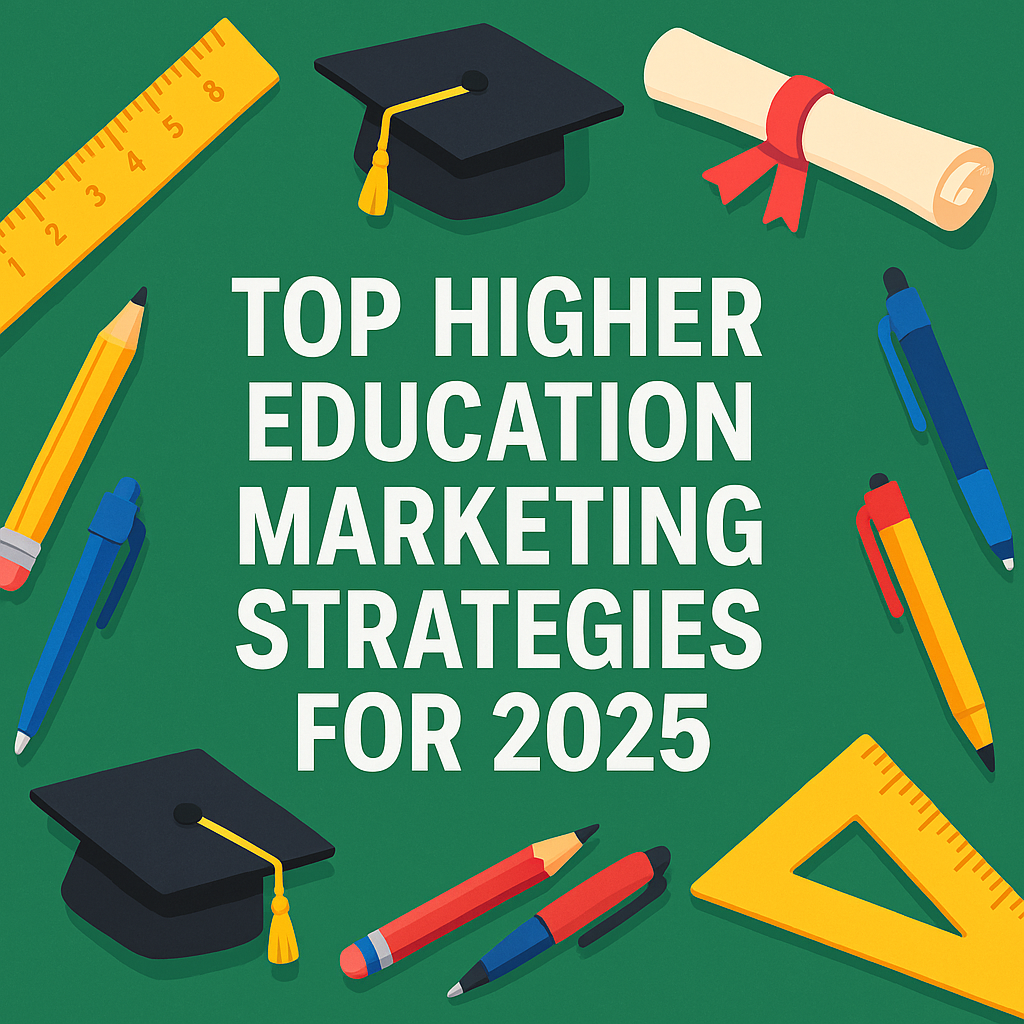The higher education landscape in 2025 presents a myriad of challenges: declining enrollment rates, intensified competition, shifting demographics, the proliferation of online learning platforms, and evolving student expectations. Institutions must adapt by meeting prospective students where they are—digitally, socially, and personally. This comprehensive guide outlines eight effective, data-driven marketing strategies that colleges and universities can adopt to boost enrollment and enhance brand awareness. Propellant Media specializes in crafting full-funnel marketing strategies tailored to the unique needs of higher education institutions. With our expertise and innovative approach, we can help you attract and retain the right students in a rapidly evolving landscape.
1. Embrace Full-Funnel Digital Advertising
A prospective student’s journey—from initial discovery to enrollment—spans multiple stages, each requiring tailored messaging and strategic channel selection. A full-funnel digital advertising approach allows institutions to engage with audiences at every phase: building awareness through platforms like YouTube, OTT, and programmatic display; driving consideration with mid-funnel tactics such as retargeting, paid social, and search engine marketing; and supporting conversion with high-intent search ads, email nurtures, and landing pages optimized for application completion.
This multi-layered strategy tailors messaging to be relevant and timely, taking into account a prospect’s behaviors, interests, and stage in the decision-making process. By dynamically reallocating budgets based on engagement levels and identifying drop-off points, institutions can improve efficiency. When full-funnel campaigns are integrated with precise segmentation and tracking, they provide valuable insights into the recruitment process and significantly enhance the effectiveness of marketing efforts.
Key Tactics:
- Segmented Campaigns: Tailor campaigns based on degree programs, geographic locations, and student personas to deliver relevant messages.
- Diverse Ad Formats: Utilize a mix of text, display, and video ads to engage audiences across different platforms.
- Retargeting: Re-engage users who have interacted with your content or visited your website, keeping your institution top-of-mind.
Case Study:
A regional college partnered with Propellant Media to implement a layered geofencing and search retargeting campaign. This strategy led to a significant increase in application starts, demonstrating the efficacy of a full-funnel digital advertising approach. Want to learn more about it? Read it here.
2. Leverage Geofencing to Target Key Locations
Geofencing is one of the most precise tools available in digital advertising—and for higher education marketers, it offers a unique opportunity to reach potential students, parents, and influencers exactly where they are, both physically and behaviorally. By setting virtual boundaries around strategic locations, institutions can serve targeted ads to users’ mobile devices when they enter or leave a designated area. But geofencing goes far beyond basic location targeting. It’s about showing up with the right message at the right moment.
For colleges and universities, ideal geofencing targets include high schools, community colleges (for transfer recruitment), testing centers (SAT/ACT), education expos, and even competitor campuses. You can also target local events—think sports tournaments, cultural festivals, or career fairs—where relevant audiences may be in attendance. When combined with compelling creative and strategic calls-to-action, geofencing helps you stay top-of-mind during critical decision-making windows.
Ideal Geofencing Targets:
- High Schools: Engage students at feeder schools who are beginning their college search.
- Competitor Campuses: Reach students considering other institutions with compelling reasons to choose your school.
- College Fairs and Events: Connect with attendees in real-time during educational events.
- Community Colleges: Attract transfer students exploring further education options.
Benefits of Geofencing:
- Precise Targeting: Reach the right audience based on their location in real time.
- Enhanced Engagement: Deliver personalized messages when users are most likely to respond.
- Increased Foot Traffic: Boost visits to physical locations through location-based promotions.
- Improved ROI: Maximize marketing effectiveness by targeting only relevant users.
- Data Insights: Gain valuable analytics on user behavior and location trends.
Example:
Propellant Media’s geofencing campaign for a local college targeted nearby high schools and SAT/ACT testing centers, resulting in a notable uptick in campus tour sign-ups and subsequent enrollments.
3. Prioritize Video and OTT Advertising
Video continues to dominate digital engagement, and for higher education marketers, it’s one of the most powerful storytelling tools available. But the shift isn’t just about using more video—it’s about placing that content where audiences are actively consuming it. Over-the-top (OTT) advertising, which delivers content via streaming platforms like Hulu, Roku, and Amazon Fire TV, allows institutions to reach households that have moved away from traditional cable. With advanced targeting options—such as geography, household income, parental status, and even college-bound intent—OTT makes it possible to place your school’s message directly in front of high-intent viewers.
Meanwhile, short-form video on platforms like YouTube, Instagram Reels, and TikTok plays a critical role in generating awareness and social proof. These formats aren’t limited to student testimonials or virtual tours (though both are effective); they can also be used to highlight faculty research, unique programs, DEI initiatives, or even the local community surrounding campus. The key is authenticity and clarity—keeping content concise, emotionally resonant, and tailored to the channel it lives on.
Strategies:
- Compelling Storytelling: Create authentic videos showcasing student experiences, campus life, and academic programs.
- Platform Diversification: Distribute content across YouTube, social media platforms, and streaming services to maximize reach.
- Mobile Optimization: Ensure videos are formatted for optimal viewing on smartphones and tablets.
Insight:
-
Viewers retain 95% of a message when they watch it in a video, compared to just 10% when reading text, making video one of the most effective mediums for communicating complex or emotional information.
-
OTT advertising has an average completion rate of over 90% on connected TVs, significantly higher than traditional display or social video ads.
-
According to a recent study, Gen Z spends more time on YouTube and TikTok than any other platforms, with video content playing a central role in how they discover brands—including schools.
-
Institutions that use personalized video content in their outreach see up to 4x higher engagement rates compared to static image ads.
-
Mobile video consumption increases by 100% year over year, underscoring the importance of optimizing all video content for mobile-first experiences.
4. Optimize for Mobile and Voice Search
With search behavior increasingly dominated by mobile and voice, higher education institutions must adapt their digital infrastructure to stay competitive. A mobile-first approach isn’t just about responsive design—it’s about delivering a seamless, fast, and intuitive experience across all touchpoints, from ad click to application submission.
If your site isn’t optimized for mobile, it’s not just inconvenient—it’s a conversion killer. Equally important is preparing for the surge in voice search, where users speak full questions rather than typing keywords. This requires rethinking your content strategy to include natural language, structured data, and location-based queries. For example, someone might ask, “What MBA programs are accredited near Atlanta?” rather than searching “Atlanta MBA programs.” Institutions that adapt their SEO and content development with voice intent in mind will have a clear edge—especially as more users rely on smart devices for research. Prioritizing mobile speed, usability, and conversational content isn’t just good UX—it’s good strategy.
Action Points:
- Responsive Website Design: Ensure your institution’s website is mobile-friendly, with fast load times and intuitive navigation.
- Voice Search Optimization: Incorporate natural language phrases and question-based keywords to align with voice search queries.
- Clear Calls-to-Action (CTAs): Make it easy for users to find information and take desired actions, such as scheduling a campus visit or starting an application.
Statistics:
-
Mobile Search Dominance: As of 2024, over 60% of Google searches originate from mobile devices, highlighting the necessity for mobile-friendly websites. Coalition Technologies
-
Voice Search Adoption: Approximately 27% of the global population uses voice search on their mobile devices, indicating a significant shift towards voice-activated queries. DemandSage
-
Local Search Emphasis: “Near me” and local searches constitute 76% of voice search queries, emphasizing the importance of local SEO strategies. DemandSage
-
Mobile Traffic Share: Mobile devices account for nearly 59% of all website traffic, underscoring the critical need for responsive design.
5. Utilize First-Party Data & CRM Retargeting
First-party data—collected directly from inquiry forms, campus visits, email interactions, and applications—is one of the most valuable assets a higher education institution can leverage. Unlike third-party data, it’s accurate, relevant, and unique to your audience. When properly segmented, this data allows marketers to build highly personalized campaigns that reflect where each prospect is in the enrollment journey. Whether it’s targeting students who’ve shown interest in specific programs or re-engaging those who started but didn’t complete an application, first-party data enables more precise, cost-effective outreach.

CRM retargeting takes this a step further by syncing your institution’s internal data with digital advertising platforms. This allows for cross-channel campaigns that reach known prospects across display networks, social platforms, and search engines with messaging tailored to their past interactions. For example, someone who downloads a program brochure might see ads highlighting career outcomes for that specific degree. These data-driven strategies help maintain engagement across longer decision timelines and ensure that prospective students aren’t lost in the shuffle.
Implementation Steps:
- Data Segmentation: Organize CRM data by demographics, interests, and engagement levels to tailor messaging.
- Cross-Platform Retargeting: Use CRM data to retarget prospects across various platforms, including social media, display networks, and email.
- Lookalike Audiences: Create profiles of your ideal students and target similar individuals who exhibit comparable behaviors and characteristics.
Example:
Propellant Media’s CRM retargeting strategies empower institutions to reconnect with prospective students more effectively. This approach has driven higher application rates while maximizing return on investment.
6. Engage Parents as Key Decision-Makers
Higher education marketing often emphasizes the student, but parents play an equally significant role in the decision-making process—especially concerning finances, safety, and long-term value. Overlooking this audience can result in missing a crucial part of the enrollment puzzle. Parents frequently conduct research on tuition, compare institutions, and encourage their children to take action. Messaging that directly addresses their priorities, such as career outcomes, campus safety, affordability, and support services, can help establish trust and alignment during the decision-making process.
Reaching parents effectively requires thoughtful channel and content choices. Platforms like Facebook, YouTube, and OTT streaming services tend to have strong reach among parent demographics and allow for demographic and interest-based targeting. Creating content specifically for parents—such as testimonial videos, financial aid explainers, or program outcome highlights—adds credibility and speaks to their concerns in a direct, informative way. By treating parents as co-decision-makers, institutions can more effectively influence the full family unit during recruitment.
Approaches:
- Targeted Messaging: Emphasize aspects such as campus safety, return on investment, student support services, and career outcomes.
- Platform Selection: Utilize platforms where parents are active, such as Facebook, YouTube, and OTT channels.
- Inclusive Content: Create content that speaks directly to parents, including testimonials from other parents, financial aid
- Feature video testimonials from other parents who can speak to their child’s positive experience.
Why it Matters:
Parents are often the gatekeepers of the college decision-making process—especially regarding finances, logistics, and long-term value. While students may drive the emotional connection to a school, parents bring a pragmatic lens, asking questions about safety, return on investment, campus support, and financial aid. Ignoring their influence can lead to missed opportunities to reinforce confidence and help move the decision forward. Research shows parental involvement can significantly increase a student’s likelihood of applying and enrolling, particularly in traditional undergraduate programs. When institutions speak directly to parents’ concerns and priorities—through tailored messaging and strategically chosen platforms—they foster trust and create alignment across the family unit, ultimately increasing the chances of conversion.
7. Highlight Career Outcomes and ROI
Today’s students (and their families) are more ROI-driven than ever. They’re asking: Will this degree lead to a job I want? That’s why marketing must move beyond amenities and prestige to focus on real-world outcomes. Highlighting job placement rates, alumni success stories, average starting salaries, and hands-on learning opportunities allows institutions to show the concrete value behind their programs. These proof points shift the conversation from cost to return, positioning education as a long-term investment rather than a short-term expense.
Career-focused content should be strategically placed throughout the enrollment funnel. At the top, storytelling works best—short videos featuring alumni working in exciting roles or brand-name companies can build emotional resonance and aspiration. In the middle of the funnel, data-driven content becomes more effective: program-specific job placement rates, internship pipelines, and industry partnerships help reinforce credibility during the research and comparison phase. As students near the decision point, salary ranges, career services support, and licensing or certification outcomes can help tip the scale.
This messaging isn’t just about satisfying curiosity—it builds trust. Students want to feel confident they’re choosing a school aligned with their long-term goals, and families want reassurance that the degree holds value in the job market. Institutions that consistently lead with career outcomes signal that they understand what matters most to today’s applicants—and are prepared to deliver on that promise.
Tips to Emphasize Career Success:
-
Use alumni success stories with specific outcomes: salaries, job titles, industries.
-
Show program-level job placement rates, internships, and grad school admissions.
-
Partner with your career services department to feature real stats and pathways.
How to Integrate ROI Messaging:
-
Add short stats to your paid social ads (e.g., “92% of Business grads employed within 6 months”).
-
Include career pathways on degree program landing pages.
-
Build out microsites for prospective students that show industry demand and salary growth.
Propellant Media has helped clients revamp their ad messaging and creative to feature these ROI-focused benefits, resulting in higher engagement and stronger conversion rates.
8. Track, Test, and Optimize Constantly
A successful marketing strategy isn’t set-it-and-forget-it—it’s an ongoing analysis, iteration, and refinement process. With the tools available today, higher education institutions can track everything from ad impressions to application completions in real time. But collecting data is only part of the equation. What sets high-performing campaigns apart is the willingness to test assumptions, analyze performance at every stage of the funnel, and make informed adjustments based on what’s working.
This involves A/B testing various creative elements such as headlines, images, and calls-to-action, in addition to experimenting with landing page layouts, audience segments, and channel mixes. For example, one campaign might find that parents respond better to video testimonials on Facebook, while another sees stronger student engagement through mobile-optimized display ads. Consistent testing reveals valuable insights, helping teams avoid wasted spending and concentrate resources on what truly drives results.
What to Measure:
-
Cost per inquiry/application/enrollment
-
Click-through and engagement rates
-
Funnel drop-off points (where students lose interest)
Smart A/B Testing Examples:
-
Landing pages with different headlines or visuals
-
CTA button colors and placement
-
Ad copy emphasizing emotional vs. factual benefits
Tools You Should Be Using:
-
Google Analytics 4 (GA4) for event tracking
-
Facebook and TikTok Pixel
-
CRM integrations with your marketing platform
-
Propellant Media’s Reporting Dashboard – a transparent and real-time dashboard all Propellant clients use to track KPIs and performance across campaigns.
This is where working with an experienced agency makes all the difference. Our team at Propellant Media uses a test-and-learn framework to continuously improve campaigns, optimizing media spending while increasing student acquisition.
Conclusion: It’s Time to Rethink Your Enrollment Strategy
Higher education marketing in 2025 demands more than just glossy brochures and open house invites. It requires a strategic, data-driven approach—one that reaches prospective students (and their families) with the right message, at the right time, on the right platform.
From geofencing and OTT ads to CRM retargeting and ROI storytelling, these eight strategies can help colleges and universities stand out in a crowded field.
But you don’t have to do it alone.
At Propellant Media, we help colleges and universities develop and execute multi-channel marketing strategies that deliver real results. Whether you’re trying to fill seats for a particular program, increase brand awareness, or expand your reach into new markets, we can help. 
👉 Contact us today for a free strategy session and discover how we can elevate your enrollment marketing in 2025 and beyond.

